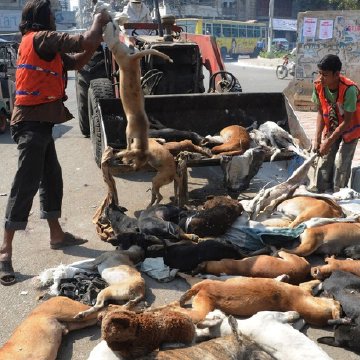Tamashbeen
 This is a distubring photo. Maybe even more than the one I had posted earlier.
This is a distubring photo. Maybe even more than the one I had posted earlier.
It shows “sanitary workers” (wow, what a ‘sanitary’ spin!) in Karachi disposing of “dog carcasses” in Karachi as part of a municipal campaign to “eliminate” stray dogs. Supposedly, there are an alarming number of stray dogs in Karachi and around 150,000 people in Pakistan are bitten by stray dogs annually.
I find the picture of so many dead dogs disturbing and I am sorry to shove it in your face, but I have been wondering whether there is a better solution to this. There has to be. But what?
Life as a stray dog in Pakistan cannot be easy or good for the dog. And as many of us know, living around stray dogs is not easy or good either. In many cases they turn into semi-wild packs and there are real dangers for people as well as dogs.
The idea that some dogs have to be put to sleep is something people do not talk much about but it is something that happens everywhere. In the US, for example, between 5-7 million dogs are “put to sleep” every year. The question really is HOW they are treated while they are alive and as they are put to sleep. And I wonder HOW these dogs were “eliminated”?
I wonder also, what the right way to do this is? I ask because I really do not know. I do know that dealing with stray dogs, not just in Karachi but everywhere, is important for people as well as these dogs. But how?
I guess I am repeating my question again and again. But that is because I really want to know. In looking for answers I discovered that there exists something called PAWS – The Pakistan Animal Welfare Society. I went through their very nicely designed and informative website, but I did not find the answers I was looking for there either. Do you have any ideas?




















































I agree with Faraz.
There are ‘better solutions’ (neuter and spay a few million stray dogs and cats so as to eliminate the future problem) but it really hasn’t worked completely in the US and is not exactly feasible in Pakistan. We can’t stop our people from excessive breeding so how are we to stop our animals? At the time of Partition, West Pakistan was about 38,000,000 (give or take), now I’ve seen figures of 180,000,000….
Atleast the dogs are in one piece at the time of death. Can’t say that for countless human beings who are dying every day in the land of the pure. Edhi sahab has been running an animal shelter in Karachi for close to two decades now. Most people in Pakistan don’t know about it. The shelter existed in Karachi only last time I checked but there were plans to make another one near Lahore. If you see an animal that needs help and you live in Karachi, the poor animal has a chance of survival or humanely being euthanized by the Edhi animal shelter if you make a phone call. In the land of the pure it is normal to treat the bey-zuban badly. We forget civility, humanity and religion conveniently like we do in most other aspects of life when it comes to dealing with animals…in the land of pak and pure. Thanks Tamashbeen for this thought provoking writeup.
It’s a country where human beings are ‘eliminated’ without any rule and any law. What shall I speak of dogs?
well I am sure the photo must be disturbing to people living outside Pakistan….here we are used to seeing many photos EVERYDAY in newspapers and Media where these dogs are generally replaced by human beings….in fact these dogs are lucky that they are in one piece ….. here the police picks up tiny pieces of human bodies from the place of explosions…..and puts them in a bag and shows those pieces to their relatives for identification……..so stop worrying about dogs just like we have stopped worrying…..cheers !
I agree with Faraz. The dogs are far too numerous. In many cases they live miserable lives, are disease carriers and scavengers. Pakistan is not the USA and does not have systems or budget in place to humanely handle this kind of problem. As far as I can see, the dogs serve no useful purpose in cities. They are not pets. They need to be controlled and this is likely the most expedient method. Of course, disposing of them in public is not the nicest thing to see.